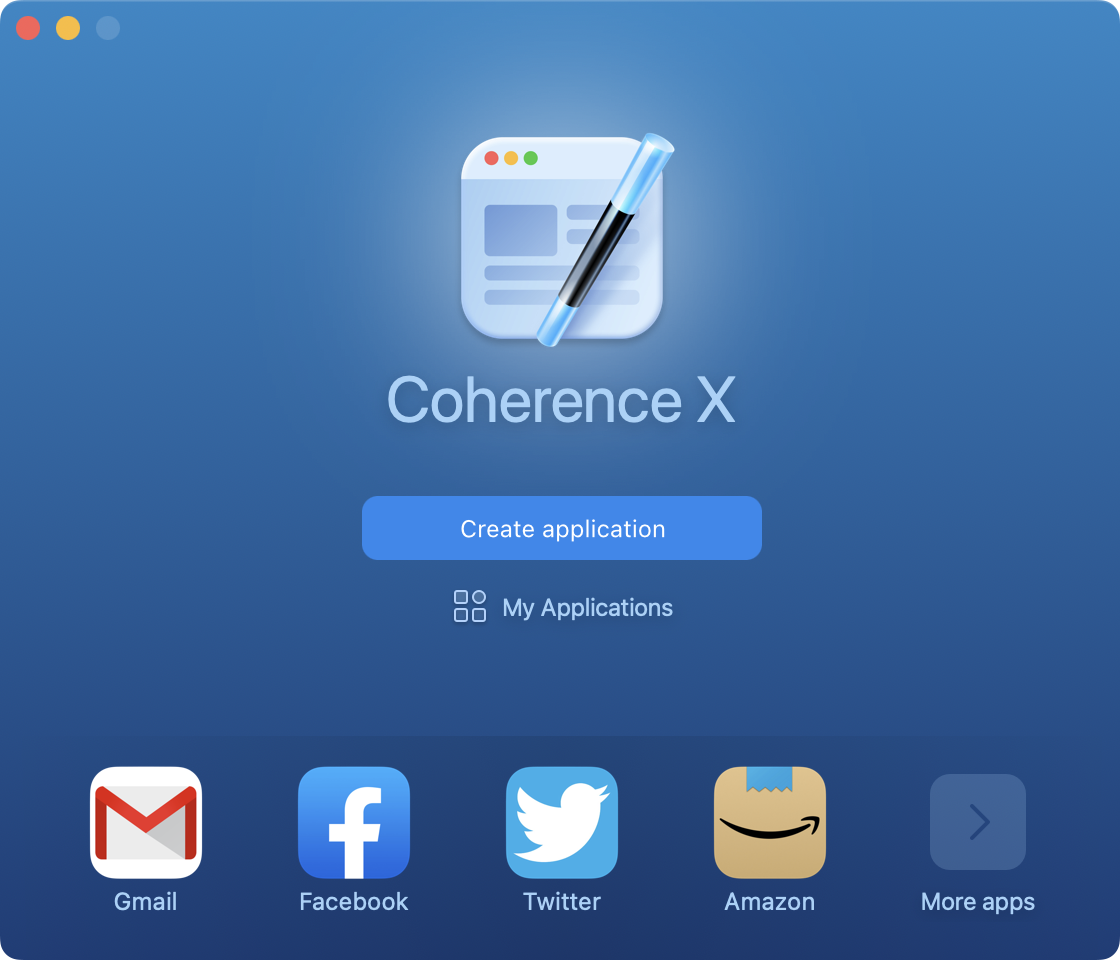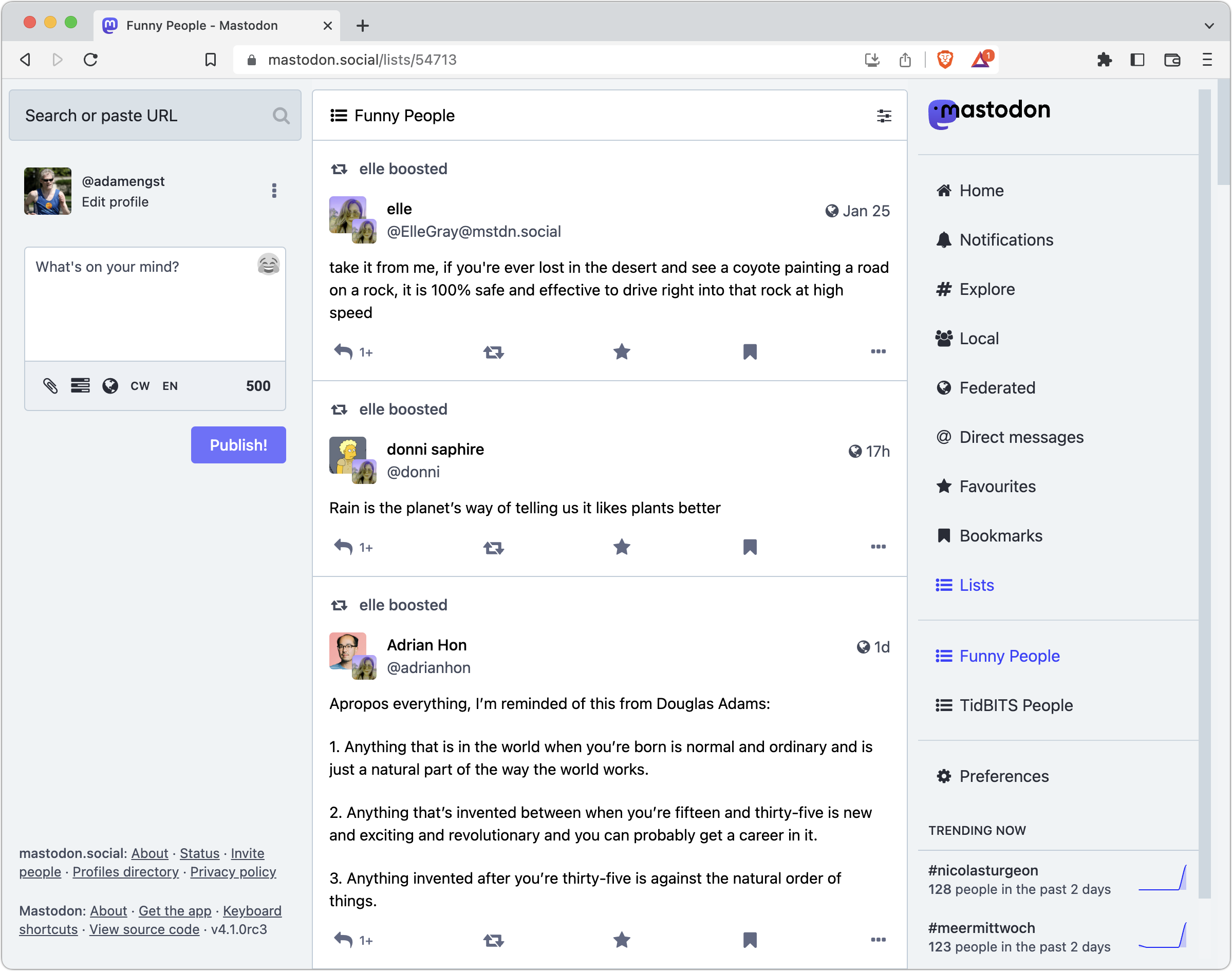Site-Specific Browser Examples from TidBITS Sponsor Coherence X
We’ve picked up a new TidBITS sponsor for the next few issues: BZG, makers of the site-specific browser app Coherence X. A site-specific browser (SSB) lets you effectively turn any website into a standalone app that appears in your Dock and works almost like a native Mac app. (BZG also makes Unite, another site-specific browser app that relies on WebKit instead of the Chromium engine underneath Coherence X, and Aerate, a lossless image compression utility.)
I’ve relied on Coherence X for the past few years because it offers the best combination of features for my heavy use of Google Docs (see “The Best Mac Site-Specific Browser for Google Docs,” 18 June 2021).
My use of Coherence X beyond Google Docs is largely limited to another SSB that brings together tabs for iStock Photo, Unsplash, Pexels, and other sites I use to find royalty-free images for my TidBITS Content Network articles. I’ve tried to turn a few other sites into site-specific browsers—including TidBITS and TidBITS Talk—but they haven’t stuck.
Upon reflection, SSBs work best for me if the site has a single unified function—just like an app. In fact, immediately after typing those words, I made a tabbed SSB for Mastodon’s Web client (a tabbed SSB ensures that I can follow links within the app). If it looks a lot like Brave, that’s the point.
However, when my activity is more general—I do many different things on my various TidBITS sites—I haven’t been able to break free from the default browser mindset, even though I’d like to. Every day, I end up with a silly number of tabs open to TidBITS articles, TidBITS Talk posts, WordPress admin pages, and more, and they clutter up my browser terribly.
Once I made the acquaintance of BZG’s Binyamin Goldman, I asked him if he had any case studies from his users that might help me—and perhaps you—glean inspiration from how others use site-specific browsers. He did, and I’d like to share ideas I’ve distilled from them about how you might improve your productivity by turning a website into an app with Coherence X or another site-specific browser.
Encapsulating Web Apps
Unsurprisingly, the most common case studies revolved around encapsulating a highly focused website into an SSB that acts like a native app. David Landes is an enthusiastic Coherence X user who regularly works with SSBs, and he provided these examples:
- He relies on the free Wave accounting package and appreciates how turning it into an app lets him focus on financial work without being distracted by other tabs.
- Breaking Netflix out into a standalone app “just feels right,” David said, and although he has another SSB for YouTube, he doesn’t use it as much. I wonder if that’s because YouTube is something you’re more likely to use opportunistically (“look, a cat video!”), rather than intentionally (“time to watch The Crown”).
- Since the start of the pandemic, David’s company has used the Whova event management platform for online and in-person conferences. The administration interface is Web-based, and he finds having it in an SSB makes for a smoother experience than letting it get mixed up with the rest of his browser tabs.
- For online training, he uses a white-label version of the cloud-based TalentLMS and prefers keeping it separate from his main browser. He goes so far as to create a separate SSB for each training to keep them distinct.
David said the big win of creating an SSB is that he can interact with it as though it were a native app. In particular, switching between apps via the Dock and Command-Tab is more natural than hunting through browser tabs. He also tracks his time using the Mac app Timing, which automatically records how long he uses each app. By creating multiple apps for the different trainings he delivers, he can more easily associate his activity with particular clients and projects.
Manage Multiple Accounts
Another common thread I encountered among the case studies was using Coherence X to create multiple SSBs for the same site, each logged into a different account. Using separate Web browsers to log into different accounts is surprisingly useful and powerful. (The alternative of using private-browsing windows is much more limited and hard to manage.)
For instance, a coach friend was having a hard time juggling separate MileSplit accounts, one for his school cross-country team and another for his club running team. The problem was exacerbated by the requirement that he use a Chromebook for his school-related work. This left him under the impression he could have only one browser at a time. (It’s possible to install a Linux or Android browser in ChromeOS, but far from obvious.) He was ecstatic once I pointed out that, on his Mac, he could log into one account in Safari and another in Chrome—he immediately did that for both MileSplit and Gmail, where he was most familiar with the Web interface.
Using Coherence X for multiple logins is a little geekier but more, well, coherent, because you can name each SSB appropriately. For instance, Haniel Massoud trains people on an Internet-based real-estate package. He uses one Coherence SSB that’s logged into his account and another that’s logged into the client’s account. That way, when he’s teaching a real-estate agent how to use the system, he can use his fully configured account as a reference while teaching from the agent’s account.
Similarly, Russel Stolins of the Institute of American Indian Arts creates multiple Coherence SSBs for the Canvas learning management system used by the campus. Most of what he does is in a Production SSB, but he and his team also use a Test SSB to check new configurations and procedures.
Online Gaming
I’m not enough of a gamer to have thought of this last use case. Some people create SSBs for online games so they can focus on the game without mixing it with work or other projects. In a case of playing your own dog food, Daniel Murray develops browser-based games like Ozwomp Online and then plays them in standalone apps using Coherence X SSBs.
I don’t have a sense of how common it is for TidBITS readers to play online games, but if there’s one you enjoy and find that it feels wrong to mix it in with all your other browser bookmarks and tabs, give an SSB a try.



I’ve a bunch of video subscriptions beyond Netflix, never feels right in Safari somehow.
It’d be nice to call them up with an app launcher too, Raycast my current choice.
But the first thing I thought of was as a PocketCasts Plus subscriber I’d like to try that.
I created an SSB using Fluidapp last summer so that I could use Twitter’s browser-based Tweetdeck. I figured that having a separate app would sandbox any cookies and trackers that Twitter tried to impose on me.
More recently, I created another SSB for Tweetdeck using WebCatalog so that I could use the Brave browser since Brave has pretty strong privacy controls built in to the browser.
I use Flotato for this.
It’s a WebKit-based SSB app where each app is ~30MB compared to Chromium-based SSB which are hundreds of megabytes each.
I use it for…
Specifics
Generally:
I only use an alternative, Nativefier, for:
Does anyone have any experience using Coherence X for WhatsApp on the web? The desktop WhatsApp app, available from the Mac App Store, is a real RAM hog.
So, in general, is Chrome. But more importantly, RAM use has been of little importance since macOS Mavericks days. Launch Activity Monitor to the Memory tab and observe the MEMORY PRESSURE gauge in the lower left corner. If it never turns red, then you have sufficient RAM for your setup.
I can recommend Flotato for WhatsApp SSB. Super lightweight WebKit compared to the Chromium-based alternatives.
There’s a WhatsApp Beta which is much better but after using it for a while it now displays an empty window. So still some work for them to do. It uses Catalyst and runs native on Apple silicon.
https://www.macrumors.com/2023/01/23/whatsapp-beta-apple-silicon-mac/
This is a really good point.
RAM is there to be used, so the theoretical best scenario is 100% RAM usage and 0% page/swap usage. Unused RAM is wasted RAM.
Many of the sites I would like to set up as an app require a secure login. ie accounting and bank sites. Can a Coherence app also login, and if so, how does it securely handle secret passwords? If not, how is it going to be any quicker than just using Safari directly?
The main attraction of SSBs is separation. Though it’s usually faster to Cmd+Tab, or click on an app in the dock, than hunt for a particular tab or window in your browser.
Of course you can login, and the login is stored and remembered for the correct duration of time as it’s WebKit/Chromium/etc at the end of the day.
Secure passwords, integration with Keychain, or 1password… it varies. Try your choice of SSB and see.
To add on to what @gingerbeardman said, one slight annoyance with SSBs is that, although they support extensions for things like password managers, you do have to install them in each SSB separately. I’ve found that it’s usually easiest to let the SSB manage and autofill the credentials for the (usually) one site in question.
I’m not aware of any SSBs that work with Keychain for passwords.
I’ve tried:
Anybody know of one?
I have been forced to use at least four different browser running all the time to “load balance” across them and to be able to being logged in to multiple Microsoft, Google, Dropbox etc. accounts at the same time. I think certain websites are perhaps best kept in a separate web app though, like Twitter, but having hundreds of web apps open at once would likely not make things work any better. Safari regularly crashes (without crash reports) these days on MBA M2 16GB, but luckily it starts quickly and remembers the tabs/windows. Good to know.
Isn’t flotato dead? I used it years ago but today when I tried to log into Google, it said my browser wasn’t modern enough.
The site seems fine here.
You will have to update your User Agent strings. Each Flotato instance saves its user agent in the main Flotato plist.
I haven’t figured out a way to do this through the GUI.
I learned this from the Flotato developer, he’s very responsive.
Can you explain? The
/Applications/Gmail.app/Contents/Info.plistcreated by Flotato does not contain any user agent strings AFAICT.Weird, after trashing the Gmail app, and creating a new one, it just logged me right in. Bizarre.
Trashing and recreating is a good way to update the user agent! Nice.
I’m not sure as to how recent the new one will be. But it sounds like it is recent enough for Google!
If it’s not recent enough, you can edit the Flotato preference file manually. The place to look is
~/Library/Preferences/com.mortenjust.flotato.plistwhich contains all User Agent strings for all Flotato instances.